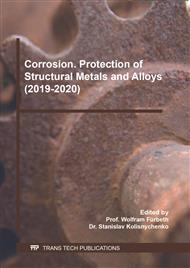p.723
p.729
p.737
p.743
p.749
p.755
p.760
p.766
p.772
Corrosion Resistance of MAO Coatings on Al-Si Alloys
Abstract:
The paper presents the results of an experimental study of the influence of micro-arc oxidation (MAO) on the parameters and the corrosion resistance of MAO-treated surfaces on a high-silicon aluminum alloy, M244 (Si ~ 25 %). The article describes the study methodology, comprising forming a coating on the surface of laboratory samples by means of MAO at different process modes and the study of their parameters, properties, and corrosion resistance. The experiments were conducted in accordance with the 23 full factorial experiment design theory. The MAO process was carried out using a silicate-alkaline electrolyte. MAO factors were as follows: the concentration of the electrolyte components (potassium hydroxide – KOH and liquid glass – Na2SiO3) and electrical parameters of the process, determined by the capacitor capacitance of the processing unit. The samples were tested to define thickness, porosity and micro-hardness of the MAO layer. Being corroded in a corrosive solution for 144 hours, their corrosion resistance was estimated by a mass corrosion rate. The data obtained made it possible to form mathematical models, based on the dependence of corrosion resistance, thickness, porosity and micro-hardness on the process factors. A verification of the obtained models was carried out to determine adequacy and their analysis. Conclusions on the extent of the MAO effect on the corrosion resistance of the samples were drawn. MAO modes were stated to have a significant impact on the corrosion resistance of the samples. MAO should be carried out using low electrolyte concentrations and a low-capacity processing unit for improved corrosion-protective properties of the coating on the M244 (Mahle) aluminum alloy. It is necessary to increase the concentration of the electrolyte components and the processing unit capacity, to obtain a thicker coating with low micro-hardness and porosity.
Info:
Periodical:
Pages:
749-754
Citation:
Online since:
January 2020
Authors:
Price:
Сopyright:
© 2020 Trans Tech Publications Ltd. All Rights Reserved
Share:
Citation:



